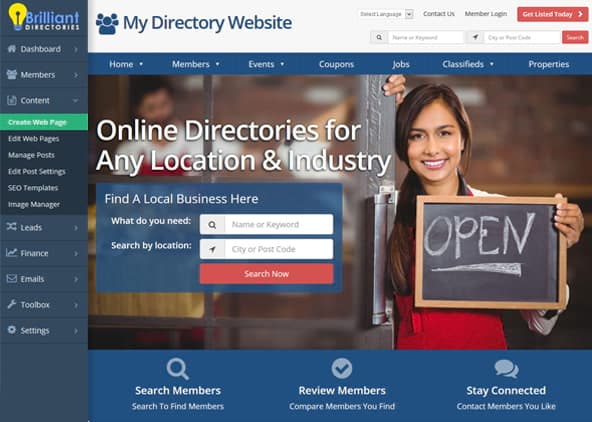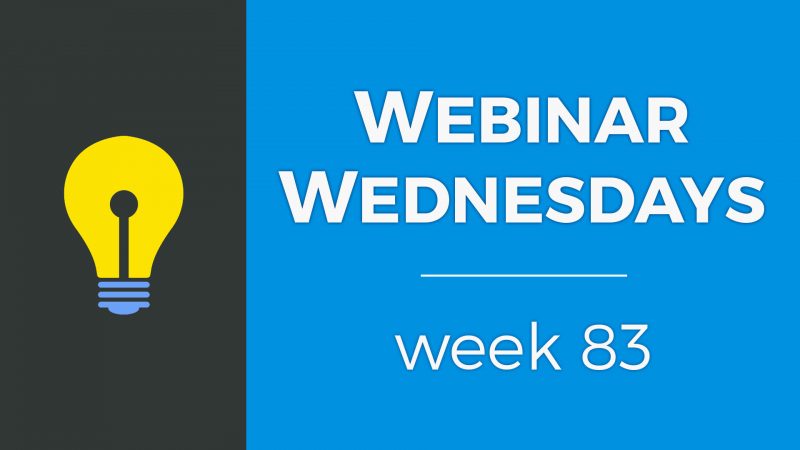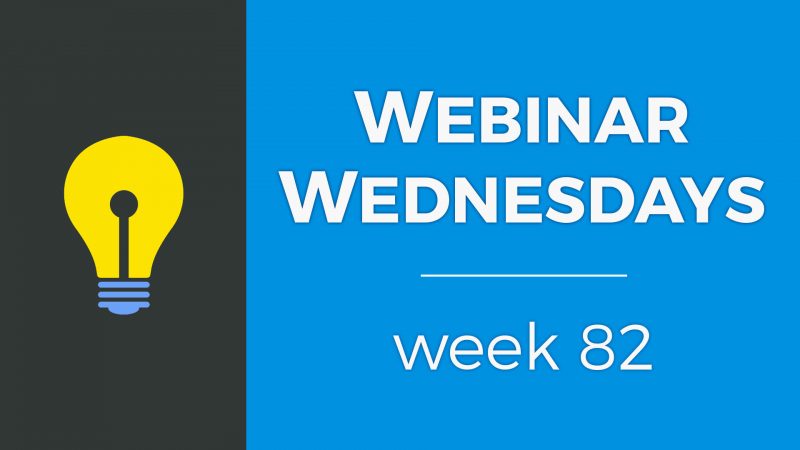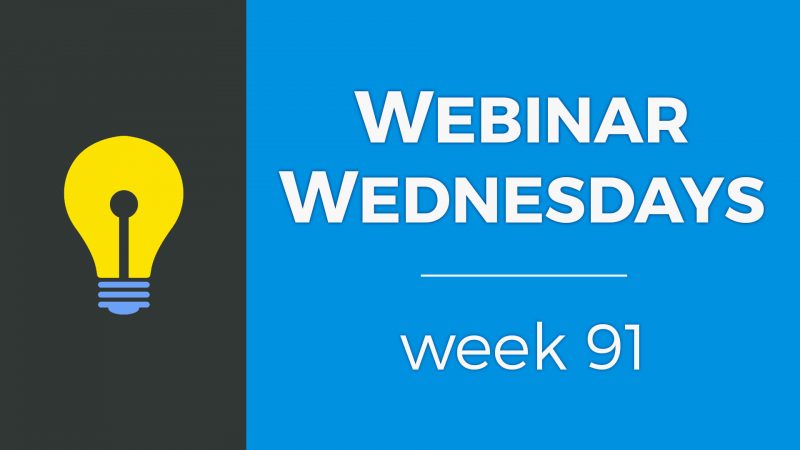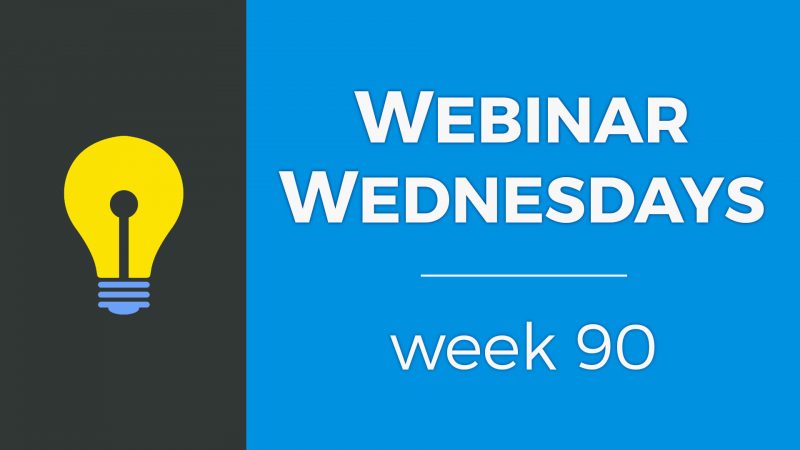
Key Topics:
- 2:21 – Bulk Actions: Select ALL Matching Results; Reviews & Leads
- 4:20 – Forms: Deployed New Patch to Minimize Spam Inquiries
- 5:08 – Settings: Show Categories with No Members
- 6:38 – Lists: Display the “Create Date” of Smart Lists
- 7:54 – New Add-On: File Uploads for Forms
- 8:51 – Stripe: Set Name that Displays on Credit Card Statements
- 9:18 – Emails: Deliverability improvements via Domain Authentication
- 9:35 – API: Ability to Import Feeds & Data INTO BD Websites via Zapier, Pabbly, etc.
- 10:12 – Member Credits System: Issue Credits when Existing Members Refer New Members
- 10:35 – File Uploads: Ability to Permanently Delete Files from System
- 12:08 – Ampify: Increase Site Speed & SEO with AMP Mobile Optimization – BD Marketplace
- 13:38 – About Ampify
- 14:15 – What is AMP (Accelerated Mobile Pages)?
- 15:17 – AMP Benefits
- 19:57 – Where Does AMP Show Up?
- 21:59 – AMP’s Value Measurement
- 23:21 – Live Demo
- 25:29 – Ampify Plans
- 26:20 – What types of websites would benefit most from AMP?
- 26:56 – Why is a cost associated with Ampify’s service?
- 27:35 – Are there any BD websites that wouldn’t benefit from AMP?
- 29:00 – Checking if a live BD website would benefit from AMP
- 30:41 – How to inquire with Ampify — Inquire Here
- 31:58 – How to bulk move members from one category to another?
- 33:08 – How to prevent certain members from receiving leads?
- 34:53 – How to search for members based on plan instead of category?
- 38:10 – How to allow additional sources for audio embeds other than Soundcloud? — More Info
- 41:54 – Using the Photo Gallery post type for podcast/video posts
- 45:44 – Options for featuring a member articles on the homepage?
- 49:00 – Change the additional information displayed for streaming members on the homepage?
New Features
Coming Soon
Tip of the Week
Questions & Answers

 AI-Generated Transcript – Please excuse any inaccuracies
AI-Generated Transcript – Please excuse any inaccuracies
Bulk Actions: Select ALL Matching Results; Reviews & Leads (00:02:21)
- New bulk actions were released for form inquiries, allowing users to bulk delete or archive multiple inquiries at once, and this feature has now been expanded to include reviews and leads (00:02:21).
- The new bulk actions feature includes a “select all matching results” option, which enables users to select all matching results from multiple pages in their admin area, rather than just the results on the current page (00:02:34).
- The “select all” checkbox has been improved to allow users to select all results, not just the ones on the current page, and this feature can be used to bulk delete or archive large numbers of inquiries, reviews, or leads (00:03:10).
- The new bulk actions feature is available for member leads and reviews, and users can use the “check all” button to select all results, including those on multiple pages, and then perform bulk actions such as archiving or deleting (00:03:33).
- The bulk actions feature can be used to target specific results, such as those from a certain IP address, and users can also use filters to select specific results to perform bulk actions on (00:03:55).
- The “select all results” option will be implemented in other areas of the admin area, such as widgets, over the next few weeks (00:04:09).
Forms: Deployed New Patch to Minimize Spam Inquiries (00:04:20)
- A new patch has been deployed to minimize spam inquiries coming through website contact forms and other custom forms, with the goal of reducing the amount of spam that websites receive (00:04:20).
- The patch is part of ongoing efforts to put in new safeguards and stay on top of spam, which is a relentless issue on the internet, and to identify and eliminate the sources of spam (00:04:32).
- If spam inquiries are still being received after the patch has been deployed, it is requested that the support team be notified so that they can investigate and find ways to stop the spam (00:04:43).
- The goal of these efforts is to minimize spam inquiries across the entire network, and it is expected that the new patch will have a positive impact on reducing spam for all websites (00:04:59).
- The support team is working to identify the sources of spam and put a stop to them, which will benefit all websites and help to eliminate spam altogether (00:04:54).
Settings: Show Categories with No Members (00:05:08)
- The settings include an option to show categories that do not have members in them, which can be useful if a site has many member categories that would produce empty results if displayed in search filters or on the categories list page (00:05:08).
- An update has been made to this setting, which now checks for active members who are part of a searchable membership plan, addressing cases where members in a top-level category were not searchable (00:05:25).
- The setting to show categories with no members can be found in the general settings under search settings, where selecting “no” will limit the number of categories shown to only those with active members who are part of searchable membership plans (00:05:50).
- If the setting is set to not show categories with no members, the front end will only display categories that have members who meet the specified criteria, creating a better experience for visitors by preventing them from landing on pages with no member results (00:06:12).
- This setting can be demonstrated on the front end through a search filter example, where categories with no members, such as “category sample two” and “sample three”, will not be shown as category options if the setting is set to not show empty categories (00:06:14).
Lists: Display the “Create Date” of Smart Lists (00:06:38)
- The admin area now displays the create date of smart lists, allowing users to reference how they are using their site or when a list was created (00:06:38).
- Smart lists are dynamic, meaning that as new members meet the criteria, the number of members in the list can fluctuate and change over time (00:06:54).
- The create date of a smart list can be found in the admin area under the “My Members” section, where all created smart lists are listed along with their creation dates (00:07:06).
- For example, a smart list named “Member Lead Inquiry” was created on May 10th, 2021, and its creation date is visible in the admin area (00:07:18).
- Smart lists are useful for exporting, segmenting, and filtering members, and can be targeted when sending newsletters to specific groups of people (00:07:38).
- Newsletters can be sent to people in certain smart lists, allowing for more granular and targeted communication with members (00:07:48).
New Add-On: File Uploads for Forms (00:07:54)
- The add-on for file uploads for forms has been released, and it is available to anyone with the VIP Add-ons Club (00:07:55).
- This add-on has various use cases, including adding it to forms for submitting job resumes, and some great examples of its usage have been seen (00:08:04).
- A link to the website will be shared, where more information about the file uploads for forms add-on can be found, including a short video on how it works (00:08:18).
- A short video is available, which provides a brief overview of the add-on, and a longer video with more details and examples can be found on the blog (00:08:28).
- The blog also contains more detailed information, longer examples, and use cases for the file uploads for forms add-on, making it a valuable resource for those interested in learning more (00:08:38).
Stripe: Set Name that Displays on Credit Card Statements (00:08:51)
- The Stripe, Inc. payment gateway will soon allow users to set and define the name that displays on their customer’s credit card statement, providing flexibility in how the name appears (00:08:52).
- This feature enables users to choose a name that may be shorter, longer, or more specific than the one registered in their Stripe account, giving them control over how they are represented on customer statements (00:08:58).
- By defining a custom name, users can ensure that the name displayed on credit card statements is different from their Stripe account registration if needed, allowing for a more personalized or specific identification (00:09:01).
Emails: Deliverability improvements via Domain Authentication (00:09:18)
- Improvements are being made to email deliverability, which is expected to enhance the likelihood of emails landing in members’ inboxes (00:09:19)
- The domain manager is being updated to include enhancements related to domain authentication, contributing to better email deliverability (00:09:21)
- These updates aim to reduce issues with emails not reaching their intended recipients, specifically by increasing the frequency at which emails arrive in members’ inboxes (00:09:25)
API: Ability to Import Feeds & Data INTO BD Websites via Zapier, Pabbly, etc. (00:09:35)
- The ability to import feeds and data into BD websites is undergoing its final QA, utilizing an API, and will also be available via integration solutions like Zapier and Pabbly (00:09:35).
- The first implementation of this feature will be to import member data into the site, with subsequent phases including the import of leads, member reviews, and posts (00:09:51).
- The upcoming phases of this feature are expected to expand the functionality of BD websites throughout the year, with the ability to import various types of data, including leads and member reviews (00:09:57).
- The integration with Zapier, Pabbly, and other solutions will enable users to import data into their BD sites, enhancing the overall functionality and capabilities of the website (00:09:42).
- The feature is expected to have a significant impact on the functionality of BD websites, allowing for the import of various types of data and expanding the site’s capabilities (00:10:07).
Credits: Issue Credits when Existing Members Refer New Members (00:10:12)
- The ability to issue credits when existing members refer new members to sign up to a site is a highly anticipated feature that is soon to be developed, with a potential release by the end of June after undergoing quality assurance (00:10:12).
- This feature has been well-received in the Facebook group, indicating a strong demand for its implementation (00:10:21).
- The development of this feature is nearing its start, with the expectation of having a release ready after it passes through its quality assurance and other necessary processes (00:10:25).
File Uploads: Ability to Permanently Delete Files from System (00:10:35)
- The ability to permanently delete files from the system is being implemented, which was a recommendation from a previous webinar, and is currently going through its final QA process (00:10:35).
- This new feature is particularly useful for sensitive files that are uploaded with form submissions, and administrators will have the option to delete these files once they are no longer needed (00:10:49).
- The delete file option will be available in the admin area, next to the file, and will permanently delete the file from the system, allowing administrators to remove sensitive or unnecessary files after verification or use (00:11:14).
- This feature will be useful for various types of files, including those uploaded with leads, and will provide a mechanism for administrators to delete files that are no longer needed or are sensitive in nature (00:11:30).
- The implementation of this feature is driven by user feedback, and is one of the updates pushed in the last couple of weeks, demonstrating the importance of user suggestions in driving platform updates (00:12:01).
Ampify: Increase Site Speed & SEO with AMP Mobile Optimization (00:12:08)
- Omer, the CEO and co-founder of Ampify, is a special guest and a newer partner in the Brilliant Directories marketplace, with a new integration that can help Brilliant Directories websites, and he will be explaining about Ampify and its benefits for the next 15 minutes (00:12:08).
- Omer will discuss what Accelerated Mobile Pages is, how it can benefit page speed and SEO, and then show a quick demo of how to use it in a Brilliant Directories site, before leaving time for questions (00:12:56).
- As the owner and founder of Ampify, Omer is based in Israel and will be covering the topic of amplifying, explaining what Amp is, and how it can improve page speed and SEO, starting with a brief introduction to Ampify (00:13:09).
- The discussion will include a demo of how to use Ampify in a Brilliant Directories site, and will provide an opportunity for viewers to ask questions about the integration and its benefits (00:13:29).
- Omer’s presentation is a special part of the webinar, which is being held in the morning instead of the usual evening, allowing him to participate and share his expertise with the audience (00:12:46).
About Ampify (00:13:38)
- Ampify is an Accelerated Mobile Pages management platform that will be used by websites to create and manage their AMP assets, which are utilized to improve web performance and SEO results (00:13:41)
- The platform has been in operation since 2019 and primarily serves content and news sites, as well as many small to medium-sized businesses (SMBs) (00:13:43)
- Ampify is based out of Tel Aviv, Israel, and the company’s scale is in the millions of managed AMP pages, with AMP standing for Accelerated Mobile Pages (00:13:57)
What is AMP (Accelerated Mobile Pages)? (00:14:15)
- AMP (Accelerated Mobile Pages) is a relatively new emerging type of web pages that are built out of different building blocks, making them extremely lightweight and fast loading (00:14:19).
- Accelerated Mobile Pages was launched by Google, which continues to push it and stands behind many of the benefits that AMP pages enjoy, making them very SEO optimized (00:14:29).
- The main incentive for websites to support AMP is its SEO optimization, and out of the top 10,000 sites online, more than 20 already have AMP support (00:14:42).
- However, the adoption of AMP really drops as you move to smaller and smaller sites, because AMP is extremely difficult and expensive to build and maintain (00:14:58).
- Fortunately, the integration with PD will enable sites to support AMP, addressing the difficulty and expense of building and maintaining AMP pages (00:15:09).
AMP Benefits (00:15:17)
- The benefits of Accelerated Mobile Pages (AMP) include page acceleration, which is achieved through two sources: being more lightweight and being pre-loaded to the user’s devices before they click to open the link, allowing pages to load near instantly (00:15:58).
- AMP helps save lost visitors by loading pages faster, as 40% of visitors are lost after just five seconds of loading time, and using AMP can help save up to 70% of those bouncing visitors (00:16:40).
- The improvement of Search Engine Optimization (SEO) is another benefit of AMP, as Google has introduced Core Web Vitals, a set of parameters to determine how mobile-friendly a web page is, and AMP pages are built to be Core Web Vitals optimized, resulting in a 30% increase in search traffic on average (00:17:25).
- By adding AMP, there is potential to increase traffic by 40 to 70% due to the improvement in bounce rate and increase in user interactivity (00:18:25).
- AMP pages have a head start over HTML pages as they are pre-loaded by Google when a user is on the search results page, allowing them to load virtually instantly, which is how Google rewards people who have AMP pages set up (00:19:18).
- The use of AMP can lead to increased website speed, reduced bounce rates, and increased user interactivity, as seen in the efforts made by Brilliant Directors to improve page load times for mobile and desktop views (00:18:33).
Where Does AMP Show Up? (00:19:57)
- When a user visits a site with Accelerated Mobile Pages support, the AMP version of the page shows up in search results, acting as a landing page that is optimized for speed, but it coexists alongside the HTML version of the page (00:19:59).
- The AMP version is a leaner and faster version of the HTML page, which may have some elements stripped down, and it is only shown as the landing page in favor of its high ranking in search results (00:20:20).
- Once the user navigates through the site, they will be served the HTML pages, not the AMP version, so the AMP version is primarily used for the initial landing page (00:20:35).
- The AMP page is what users see first when they click on a link to a website from a Google search, but as they continue clicking into other links, they will be served the regular mobile-friendly web pages of the website, not an AMP version (00:21:28).
- After installing AMP and having the basic pages live, the next step is to determine how to know if it’s working, which is a topic to be explored after understanding how AMP comes into play in the user flow (00:21:53).
AMP’s Value Measurement (00:21:59)
- There are two approaches to measuring the Accelerated Mobile Pages value, with the first approach utilizing Google Search Console, which provides various options to assess mobile friendliness, page speed, and site ranking (00:21:59).
- To measure the AMP value using Google Search Console, it is necessary to look for as many pages as possible that have high core web vitals, which are indicated by a green score, and all AMP pages have high core web vitals scores (00:22:21).
- Once AMP is added, the core web vitals score can be checked, and over time, the ranking is expected to improve, although it may take some time for the results to show up (00:22:32).
- A more immediate way to see the results of AMP implementation is by experiencing the page firsthand, such as searching for it on Google and observing how fast it loads, or using available tools like those provided by Google or Amplify (company) to preview the results (00:22:50).
- These tools allow users to preview the results even before they go live, providing a quicker way to assess the effectiveness of AMP implementation (00:23:06).
Live Demo (00:23:21)
- To use Accelerated Mobile Pages in a directory site, the only thing that needs to be remembered is how to get to the installation, as exact instructions will be provided afterwards, and this process starts by searching for Brilliant Directories Ampify or going to the link that Jason would provide later (00:23:21).
- Once the site is reached, signing up is required, after which an activation code will be sent, and this code needs to be pasted in the designated setting in the BDD dashboard, with instructions also being provided for this step (00:23:39).
- After completing the installation and activation, the AMP version of the site will be live, meaning every member profile page will have an AMP version, which can be accessed by adding a short string to the URL, and this version is only served to mobile visitors (00:24:11).
- The AMP version of a page looks and behaves exactly the same as the traditional HTML version, but with the added benefits of improved SEO, preloading, and a faster experience, and it is essential to review these pages to ensure everything works as expected (00:24:31).
- After verifying that the AMP version is working correctly, it is possible to wait and see the results in the search console after a few days, and various plans are offered for this service (00:25:19).
Ampify Plans (00:25:29)
- The Ampify Plans are based on the number of members in a site, with three plans available: Basic, and two other plans, priced at $10, $25, and $40 a month, with pricing matched to the initial pricing of extensions in BD (00:25:31).
- Every plan includes a 30-day free trial, allowing users to test the service before committing to a paid plan (00:25:50).
- Each plan has a specific member limit, and it is not possible to apply a plan to a site with more members than the plan allows, so sites with more members require a corresponding plan (00:25:55).
- For sites with over 50,000 members, a custom implementation will be discussed on a case-by-case basis following sign-up (00:26:10).
- The plans are structured in a way that all members on a site will receive an Accelerated Mobile Pages version if the site is subscribed to a plan, with no option to apply a lower-tier plan to a larger site (00:26:00).
What types of websites would benefit most from AMP? (00:26:20)
- Websites that rely heavily on search traffic would benefit the most from having AMP versions of their pages because it can improve their search traffic, (00:26:26)
- Sites that manage communities where traffic comes from groups, such as Facebook groups or Twitter, and not from search engines, would not need AMP versions of their pages as much, (00:26:43)
- The decision to use AMP depends on the source of a website’s traffic, and websites should consider the cost associated with creating AMP versions of their pages, (00:26:20)
Why is a cost associated with Ampify’s service? (00:26:56)
- A cost is associated with having Accelerated Mobile Pages pages, and this cost is due to Amplifi.io being a business that hosts and supports these pages on its servers (00:26:56).
- The cost of creating and supporting Amp pages is comparable to paying a monthly fee for hosting a regular site, as Amp is essentially another site that requires constant updates and serving (00:27:06).
- The hosting and maintenance of Amp pages by Amplifi.io involves constantly updating and serving the site, which is similar to the hosting of a regular site, and this is the reason for the associated cost (00:27:12).
- For those who have questions about Amp pages or want to know if their site is a good candidate for Amp, it is a good time to ask questions and get clarification (00:27:26).
- Omer is available to answer questions about Amp pages, and users can raise their hand to ask him a question about the topic (00:27:31).
Are there any BD websites that wouldn’t benefit from AMP? (00:27:35)
- There are certain types of business directory (BD) sites that may not be improved by Accelerated Mobile Pages (AMP), specifically those that rely heavily on third-party components that are not AMP compliant, which could lose their usability without these components (00:27:36).
- Profile pages that rely extensively on non-AMP compliant third-party components may not benefit from AMP, and in such cases, it might be necessary to reconsider using AMP (00:27:56).
- If third-party components like sidebar modules are not necessary, they can be stripped out of the AMP version of a page, but if they are necessary, it may not be desirable to create an AMP version of that page (00:28:19).
- However, if a site is a light user of third-party components, such as a chat widget that is not AMP compliant, and the site owner is okay with it not showing up in the AMP page view, then AMP can still be a good fit (00:28:33).
- In cases where the loss of certain features is acceptable in favor of having a great landing page, AMP can be beneficial, and the site can still benefit from using AMP (00:28:42).
Checking if a live BD website would benefit from AMP (00:29:00)
- The site apprenticeshipsdirectory.com is being reviewed to determine if it would be suitable for Accelerated Mobile Pages, with the site’s listing page being examined, and it is found to be an excellent fit for AMP (00:29:13).
- The site’s owner inquires about the pricing for AMP, wondering if it is a separate payment or added to their existing bill with Brilliant Directories, and is informed that it is separate (00:29:51).
- The owner is advised to submit a request to see if their site is a good candidate for AMP pages, and can reach out to Omar or the site for any questions or concerns (00:30:08).
- Omar provides contact information, stating that questions can be directed to the site or to him directly at ampify dot io, and thanks everyone for their time (00:30:27).
- The discussion comes to a close, with an invitation for further questions and the sharing of a screen to continue the conversation (00:30:38).
How to inquire with Ampify (00:30:41)
- If individuals are interested in Ampify, they can click on the sign up link, which does not require payment, and Omar and his team will follow up to determine if the site is a good candidate, primarily for sites that rely heavily on Google search results for traffic (00:30:42).
- Sites with small, private, or niche communities that do not rely on Google search results for traffic may not need Ampify, as they may not benefit from its features (00:31:01).
- A general Q&A session is available for individuals to ask questions about Ampify or seek assistance with their membership website, with support available from the team (00:31:18).
- The ability to give credits to members is expected to be an exciting feature, similar to a built-in affiliate program, with a potential release date before the end of June (00:31:40).
- Additional features, such as searching by categories that are not filled, are also being developed and are considered cool and useful (00:31:56).
How to bulk move members from one category to another? (00:31:58)
- A top-level category was created early on, but it is no longer critical, and there is a need to either pause it, put it in draft mode, or remove the members from it (00:31:58).
- To manage members in a top-level category, an option is to search for all members who are part of that category, select all the members in the search result, and then update their top-level category to switch them to another corresponding category (00:32:22).
- The search function can be used to find members in a specific category, such as “sample one”, and then select all the members in the search result to update their category (00:32:30).
- In a specific case, a category called “resources” was created, but the matchmaking feature is not a fit for it because it aims to match podcasters with guests, not with companies offering resources (00:32:54).
- The “resources” category contains companies offering resources, and there is a need to manage the members in this category, possibly by switching them to another top-level category (00:33:00).
- The option to update the top-level category of multiple members at once can be useful in this scenario, allowing for a bulk move of members from one category to another (00:32:42).
How to prevent certain members from receiving leads? (00:33:08)
- To prevent certain members from receiving leads, a new lead flow action or lead matching rule can be created and applied to their specific membership plan, ensuring they do not receive direct or indirect leads (00:33:24).
- The action can be customized to exclude the membership plan from receiving leads by turning off all options, thereby preventing them from getting any leads at all (00:33:46).
- To eliminate certain members from the get match form, the form can be customized to modify the top level category field, allowing for a drop-down with specific options, such as podcasters and guests, with corresponding ID numbers (00:34:21).
- By customizing the get match form, the top level category field can be restricted to display only specific options, with the value saved being the ID number of the top level category, which should suffice in achieving the desired outcome (00:34:35).
- Further assistance and customization can be provided through the Facebook group, where specific requests can be addressed and implemented on the site (00:34:46).
How to search for members based on plan instead of category? (00:34:53)
- To filter members by membership plan instead of category, each membership plan can have a URL associated with it under the search visibility, allowing for searches to be conducted within a specific plan (00:34:55).
- The process involves adding a search module in the sidebar and modifying it to conduct searches only for members within a specific plan, which can be achieved by editing the code of the search module (00:36:44).
- For cases where there are multiple membership plans with different tiers, a top-level category can be used to search across all plans within that category, such as searching for all authors across different membership plans (00:37:18).
- To implement this, a URL needs to be assigned to each membership plan, and then a search module can be added to the sidebar to search for members within that plan, with the option to use get parameters to filter search results (00:36:19).
- The solution may require some editing of the search module code, but it is not too complicated and can be achieved with some simple modifications (00:37:40).
- For more complex scenarios, using a top-level category and assigning multiple URLs to different membership plans can help achieve the desired search functionality (00:37:20).
- The Facebook group is a resource where one-off questions can be asked and simple solutions can be found to achieve specific search functionality (00:37:43).
How to allow additional sources for audio embeds other than Soundcloud? (00:38:10)
- Members can use a different link and not just Soundcloud to embed audio, as the Soundcloud post type is almost obsolete and there is a method to support iframes and embeds from almost any other source (00:38:28).
- To allow members to embed podcasts from other sources, they can watch a video that shows how to whitelist other domain sources, which will allow them to create an article and embed a podcast from another source into their post (00:38:52).
- Members can create a post type called “podcasts” and organize their content accordingly, or they can use the existing article post type and create different categories for articles, including a podcast category (00:39:26).
- To create a new post type for podcasts, members can clone the community article post type, edit it, and give it a different nickname, such as “member podcasts”, and then update the search results title (00:40:17).
- The new post type can be assigned to membership plans that have the privilege of posting member podcasts, by searching for “podcasts” under post publishing for a membership plan and selecting “can post” (00:41:02).
- To embed podcasts or other content from third-party websites, members can whitelist the websites in the advanced settings, which will allow them to embed content from sources other than just Soundcloud and YouTube (00:41:35).
Using the Photo Gallery post type for podcast/video posts (00:41:54)
- Using the photo gallery post type can be beneficial for podcast or video posts because it allows for the addition of a video link instead of just images, enabling the display of an image in search results and a video on the actual page (00:41:54).
- The photo gallery post type can be modified to show a video by turning on the “enable photo galleries with videos” setting in the admin settings, which is found in the post type settings under “additional settings” (00:43:59).
- Once the setting is enabled, a YouTube video URL can be pasted into the photos tab of the post type, allowing for the display of a video in the photo album, and this can be used in conjunction with uploaded images (00:44:34).
- This feature is useful for property sites that want to show virtual tours, and it can also be used for podcast posts by uploading an image and then displaying the audio version of the video in the photo album (00:44:56).
- The benefit of using the photo gallery post type for podcast or video posts is that it allows for the best of both worlds, displaying an image in search results and a video on the actual page, as mentioned by Ryan (00:41:54).
- The process of creating a photo album and modifying it to show a video involves logging in as a sample member, creating a new photo album, uploading an image, and then enabling the “enable photo galleries with videos” setting to add a video link (00:42:56).
- The photo album can then be used to display a video, such as a podcast, and the image uploaded will be shown in search results, while the video will be displayed on the actual page (00:45:21).
Options for featuring a member articles on the homepage? (00:45:44)
- When a member creates a blog article, they have the option to feature it on the home page, but they cannot choose which specific articles to feature or not, with the settings related to this option being explored (00:45:45).
- To stream articles or content on the home page, there are design settings that can be utilized, including adding articles and editing the settings to only show posts with photos, from active members, or from non-searchable members (00:46:18).
- The settings also allow for including posts only from specific membership plans, which can be useful for limiting which members’ articles are featured on the home page based on their membership plan association (00:47:06).
- Members cannot pick and choose which of their articles are showcased on the home page, and the display of articles is limited by the membership plan and the settings available (00:47:33).
- An alternative option for more granular control is to create a custom content section on the home page, which allows the website owner to manually choose which articles to feature, although this is a more manual process (00:47:52).
- This manual process involves updating the custom content section to match the desired articles, giving the website owner full control over the content displayed on the home page (00:48:11).
- The current settings do not allow members to have control over which of their posts are added to the home page streaming sections, and it is dictated by the available settings (00:48:36).
Change the additional information displayed for streaming members on the homepage? (00:49:00)
- The issue of displaying only the top category for streaming members on the homepage can be resolved by changing the additional meta information settings, which currently defaults to the top-level category (00:49:03).
- The settings can be toggled to display sub-level or sub-sub-level categories, with the recommendation to choose sub-level category in this specific case, as not all members have sub-sub-levels (00:49:35).
- Alternatively, the short description or about snippet of the member can be displayed as additional information, and the most useful option for visitors can be determined through experimentation (00:49:58).
- To change the display settings, users can scroll down in the settings and find the “display additional information” option, where they can select the desired category level (00:50:12).
- The webinar also covered other topics, including a reminder about Ampify and its 30-day free trial for implementing Accelerated Mobile Pages pages on directory sites, as well as an invitation to join the Brilliant Directories Facebook group and subscribe to their YouTube channel for future updates (00:50:31).

